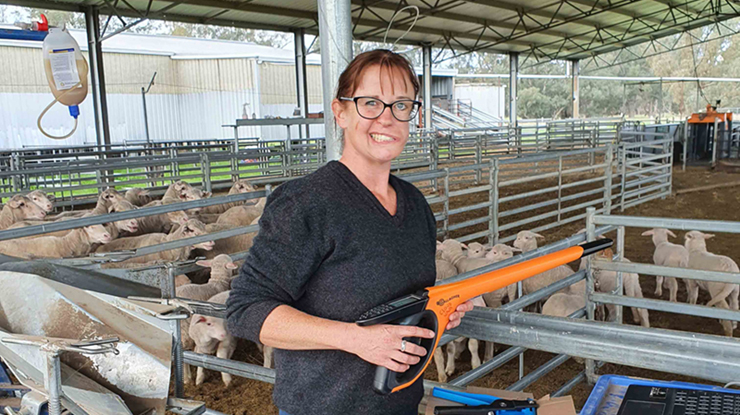 Anna Toland scans eID tags to collect data to guide flock management decisions.
Anna Toland scans eID tags to collect data to guide flock management decisions.
Recording and improving traits of genetic merit have played a key role in ensuring Victorian sheep producers, the Toland family, can make informed decisions to achieve their breeding and production goals.
They were early adopters of electronic identification (eID) in their Poll Merino stud at Violet Town, implementing eID tags in 2007 – 12 years before it was mandated for sheep in that state. The Tolands initially used the tags as a tool to collect data to improve the genetic merit of their stud lambs. Since taking over management of the family business in 2020, third‑generation producer Anna Toland and her husband Simon Riddle have continued to utilise eID to boost on‑farm productivity. They now record to improve more than 50 genetic traits. With eID tags now mandatory for all Australian sheep producers, Anna shares her insights and advice on how eID can help commercial Merino producers harness the power of data.
Improving key traits
In their goal to breed advanced, all‑purpose polled Merino rams, the family's business has been heavily focused on improving growth, carcase quality and wool traits of their flock for the past 60 years. While Anna said they've made many changes to their production system over the decades, using eID for data collection to aid reproduction decision making has been a game changer.
"Over the years, we've been steadily increasing the traits of genetic merit we record data on," she said.
"So, it's really done a great job at putting us in a position where we can make reproduction calls with confidence."
In addition to recording her animals' genetic merit for target traits, Anna also inputs her own notes into the database.
"While genetics do play a huge role in indicating how an animal's progeny will perform, I also like to note additional factors relating to each ewe's productivity and ability to mother," she said.
"I'll record their weights, but I'll also note if they're missing any teats, what their toes are like, if they've had and reared multiples, and if their teeth are showing any sign of wear.
"I'm ultimately putting myself in the best position to make reproductive and flock management decisions."
Health and welfare
Like many Australian red meat producers, improving animal health and welfare traits has become a growing priority for the Tolands over the years.
"We've also been utilising eID data collection to concentrate on improving dag scoring, worm egg counts and reducing breech wrinkle," Anna said.
"These are traits I feel are really important for commercial breeders as they combine to produce an animal that is easy to care for – something which will benefit not only the animal, but you and your business."
Productivity gains
Since introducing eID, Anna said there has been a clear return on investment.
"On‑farm management and decision making have been seamless thanks to eID allowing us to collect lifetime flock data, use that data to boost our business production, and then integrate that data through the supply chain to better showcase rams we sell," she said.
"In 2024, we weaned 120% of lambs to ewes joined and 59% of our stud ewes scanned with twins were able to successfully carry them to term and raise them," she said.
"Selecting for resilience through fat and muscle scoring has played a key role in improving ewe body condition which, in turn, has allowed our ewes to regain condition quicker after lambing and weaning." Anna said they even have a few eight‑year-old ewes, which continue to earn their place year after year.
"They've remained productive and possess sound mouths and weights, and serve as a great indication of how beneficial using eIDs to collect and use data that focuses on improving genetics has been to our flock's long‑term productivity and profitability."
First step with eID
According to Anna, the first step to making the most of eID is to determine your breeding objectives.
"This enables you to then identify which genetic traits will align with achieving your objectives," she said.
Anna suggests producers keep it very simple to begin with and start by focusing on just a few traits. When they've perfected the recording and analysing process of these traits, they can expand to improving other genetic traits.
"Patience and consistency are key when it comes to investing in data collection and improving genetic traits, so make sure you're putting your energy and time towards data you know you will use.
"While we did see small improvements occur every year during our induction of eIDs, it wasn't until that three to five‑year mark when we saw significant gain on the quality of our flock's productivity and profitability.
"The ability to retrieve accurate data in a timely manner paired with those gains does deliver a moment of, 'oh, this is really worth it'."






